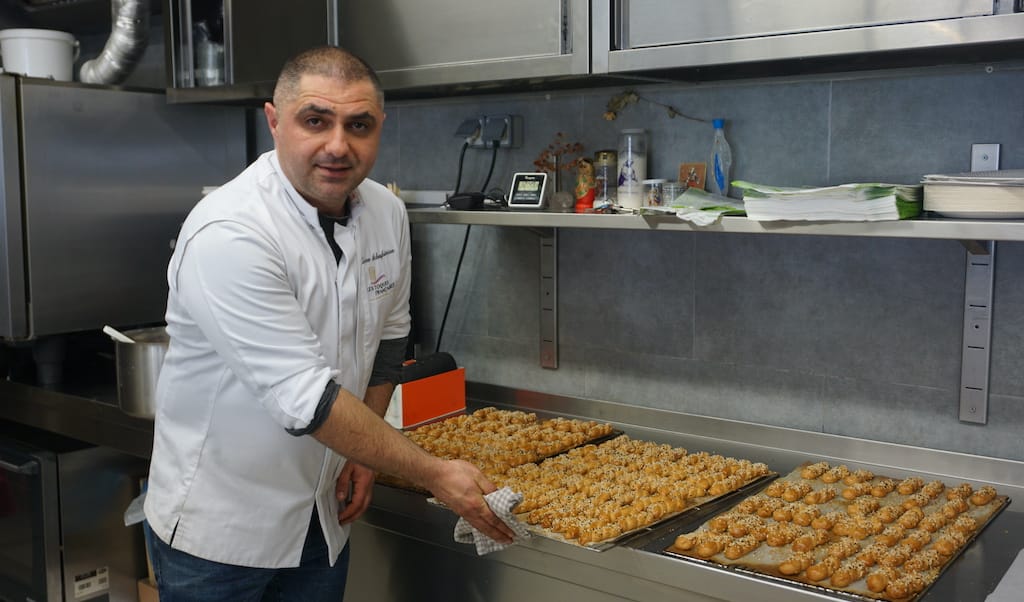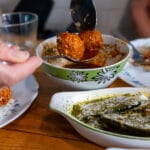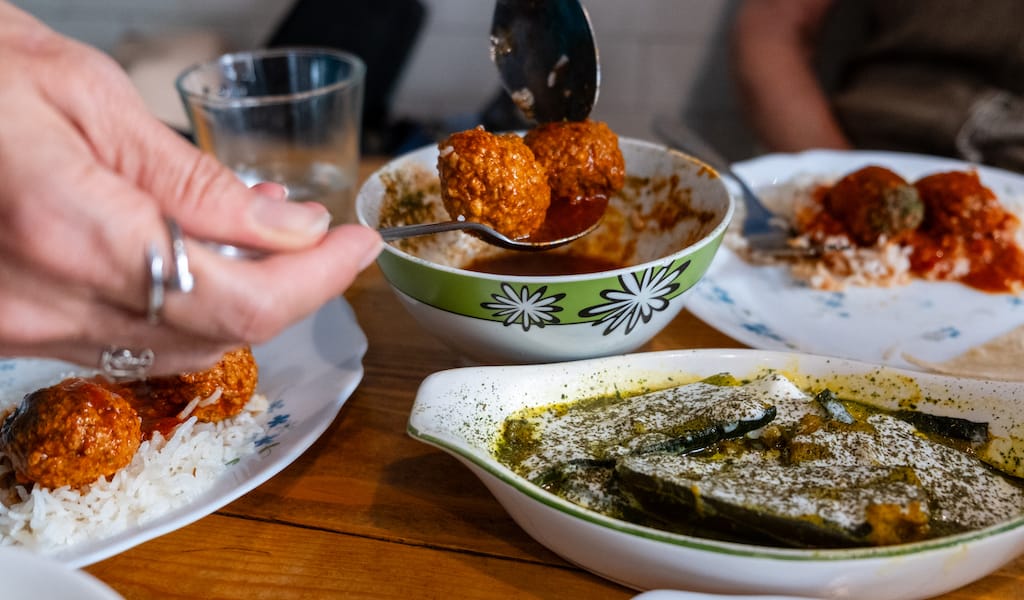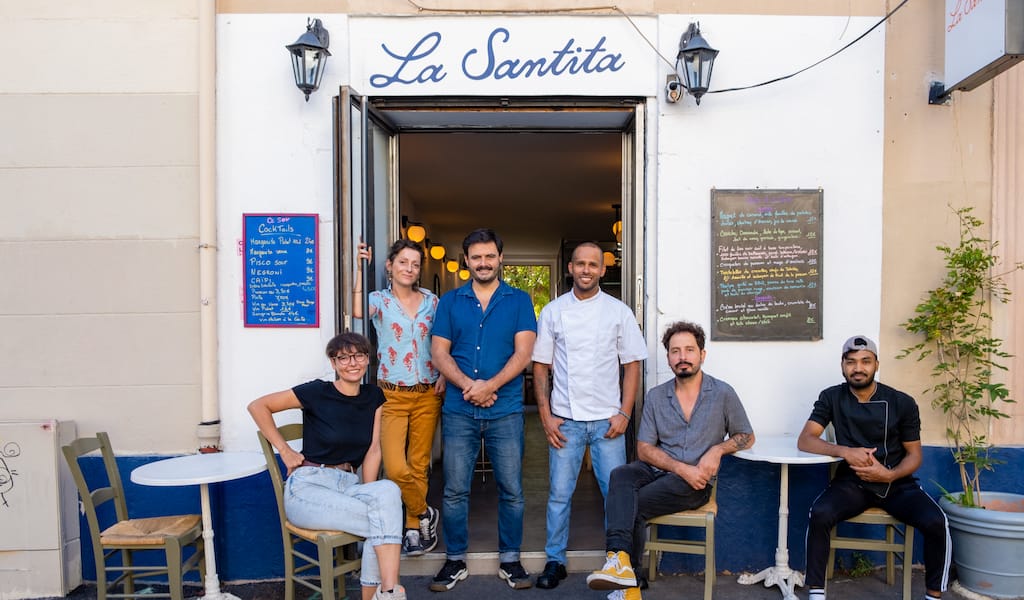Marseille is home to the biggest Armenian community in Europe, with cultural centers, churches, and several neighborhoods with a significant Armenian presence. Most fled the Armenian genocide of 1915-1922, joining a smaller and older Armenian community of merchants that settled in Marseille starting in the mid-nineteenth-century. The different waves of Armenian immigrants and refugees, coming to some 80,000 people, maintain ties to Armenia, family, and culinary traditions, and many eventually thrived.
Armenian cuisine is rich and varied, and yet what is available in Marseille’s city center in terms of actual restaurants and takeout doesn’t reflect that. Because Armenian cuisine is a home cuisine, it is often in private houses that we enjoy the traditional dishes like kabab karaz, meatballs in sour cherry sauce, or manti, clusters of small, open raviolis of spiced meat. However, the Armenian community of modern families often buys certain prepared foods chez les traiteurs (from the caterers), like lahmajoun (spiced minced meat atop flatbread), beurek (phyllo dough turnovers filled with cheese, vegetables, or meat), cooked meals, as well as cookies and sweets. So we headed to Sassoun traiteur in the historic Armenian neighborhood of Beaumont (a 20-minute drive or 40 minutes by public transport from the center), highly reputed in the neighborhood and beyond.

Sassoun is located on the main commercial street of a pretty, tree-lined residential area with low buildings and small houses. In its vast, open kitchen, we find the owners, Karen Achoughatoïan and his wife Anahit Gangyan, other family members and employees, pulling out of the oven trays of Armenian koulourakia, dry, biscotti-like sesame cookies, and cooking large vats of food, creating a heady swirl of aromas savory and sweet. The longest vitrine displays the daily cooked meals and Levantine salads (humus, baba ghanoush, tabouleh). Another one holds the beurek and sweets, like Armenian baklava, gata (sweet bread), and donuts, to name just a few, and yet another flaunts beautiful French pastries.
We looked about worriedly for the lahmajoun, and ask if they have it. “Of course, how many?” Anahit responds, turning towards the back kitchen. Since the lahmajoun are very thin, we order a stack, in addition to salads, beurek, the koulourakia that just emerged from the oven. We fill up the only table in the place, and sit down to sample all the fresh food. We return to the counter and ask for hot sauce for the lahmajoun. “Well, people generally order takeout, and have their hot sauce made at home, but I can give you piment powder,” she offers. Looking at us thoughtfully, she adds, “If you like hot food, as I do, there is a fantastic Pakistani restaurant in La Valentine…” We know we will eat there soon, partaking in the culinary sport of Marseille’s peripheral neighborhoods – in seeking out les petits coins, or “little corners,” special places to eat, and in talking to people, we can discover a chain of good recommendations that take us from one neighborhood to the next.

Sassoun is a gold mine. The lahmajoun is superb, and took us back to the Armenian quarter of Jerusalem, to a domed, antique stone edifice (now closed, as the Armenian quarter is increasingly overtaken by the Jewish one), that we would frequent as students in big gatherings, ordering a tower of pies so high they are etched into our memories (lahmajoun are always stacked, like pancakes). Sassoun’s lahmajoun has thin, thin crusts with slightly crispy edges, a tender center, spread with spice-perfumed, finely ground beef or lamb (the mixture includes onions, garlic, red pepper, tomatoes, parsley, paprika, and hot red pepper). The beurek is dreamily flaky, the cheese filling flavorful. And the Armenian koulourakia is crunchy, very lightly sweet (with a hint of savory), and so addictive that later we continued to nibble on them at every stoplight all the way back to Marseille’s center, thus finishing off our stash. Instead of tabouleh, we were hoping to find itch, the Armenian version, more pungent, predominantly bulgur wheat, with tomatoes, onions, lemon, and condiments, but all of Sassoun’s levantine salads are fresh and delicious. We had no room left for the cooked dishes, which change daily and look enticing (stuffed grape leaves, stuffed eggplants, boombas (stuffed meatballs)). Anahit, trained at Paul Boucuse in Lyon, makes all the dishes.

“Do you see how much food we have in our display case?” the owner asks. “A limited quantity,” he continues. “Why? Because all is made daily and fresh – all is fresh – nothing from yesterday. Many traiteurs, Armenian ones in this neighborhood, for example, have mountains of food displayed, and you know they cannot sell it all in one day.”
He moved from Armenia to Marseille to join family members already settled here. He worked for his uncle, who started Sassoun a generation ago, in a 20-square-meter storefront a few doors down the street. Sassoun is named for an Armenian town where his uncle grew up, and today it is part of Turkey, which reduced Armenia’s borders significantly, explained Karen. The name of the restaurant marks an absence and a longing (much like the practice of other exiled peoples, like some Palestinians, as we noted in our exchange, who name their daughters, especially, after their hometowns). When his uncle passed away, Karen took over, moved to a larger space, and expanded into an even more thriving business. He was inspired by his family and community who had to start over after fleeing the genocide, the earthquake, and, these days, an Armenia struggling economically, with levels of corruption too high to successfully run a business. His father had a large tapestry factory in Armenia that was destroyed by the 1988 earthquake, and he moved to Marseille to recreate his business, but without the same means. But by the next generation, it seems, a certain prosperity was possible.

When we asked Karen if we could photograph those delicious cookies coming out of the oven, he suggested, instead, photographing the vitrine of French pastries of which he is very proud. “But you’re here from for the Armenian food, right?” We nodded. As it happens, he was trained as a pastry chef at Alain Ducasse, and innovated significantly on the forms. He extracts most of the butter and fat he uses, reduces sugar, using spice to perfume the sweets. Another important innovation is a savory spice, first added by accident in his uncle’s day, “ruining” the cakes – until his uncle discovered the result was exceptional, and how Karen continues to add secret savory spice to his pastries. “The Armenians like to improvise,” he tells us. We tasted a few gâteaux both Armenian and French, and he generously offered us even more. Light, delicious, with a play on different textures and, indeed, a barely detectable additional flavor, enhancing the French pastries. We could not guess which savory spices were added, but knew we would be back for this unexpected find at Sassoun. And, of course, we changed our minds and photographed his French pastries as well.
Karen explains that the best moments of his career since he opened Sassoun’s new doors are when the pastry chefs who trained him pay him a visit, and eat and love his cakes – and they walk out with Armenian delicacies as well. Before we reluctantly leave, he shows us his well-merited culinary certificates and awards (he was nominated as the ambassador of Armenian cuisine in France, and is the only Armenian Disciple Escoffier). We plan to venture back to try more of his Armenian and French creations, and, of course, order a column of lahmajoun.
Jenine AbboushiJenine Abboushi
Published on April 06, 2023
Related stories
April 19, 2024
MarseilleAt the end of a long wooden table, a foursome passes colorful plates of food: mouthwatering meat dumplings in tomato sauce, sauteed zucchini topped with minty yogurt, and rice flecked with cumin. Sitting across from a refrigerator, below a row of fake potted plants and beside shelves stacked with mismatched plates, they could be dining…
November 7, 2023
MarseilleWe all have our favorite watering hole – that place close to home where you can have a bite to eat, sip on your preferred drink, have a chat with neighbors, friends, strangers. A place where you feel welcome and frequent often. La Santita, a tiny Latin American restaurant located on the tree-lined Boulevard Eugène…
June 29, 2023
MarseilleItalian and Maghreb restaurants are undoubtedly the stars of Marseille’s food scene. In fact, Marseille is so chock-a-block with pizza it’s rumored to have more pizzerias per capita than New York City. Eateries dishing out copious bowls of couscous equally abound. Meanwhile, some of the diverse city’s most prominent immigrant communities – and their cuisine –…





















































































